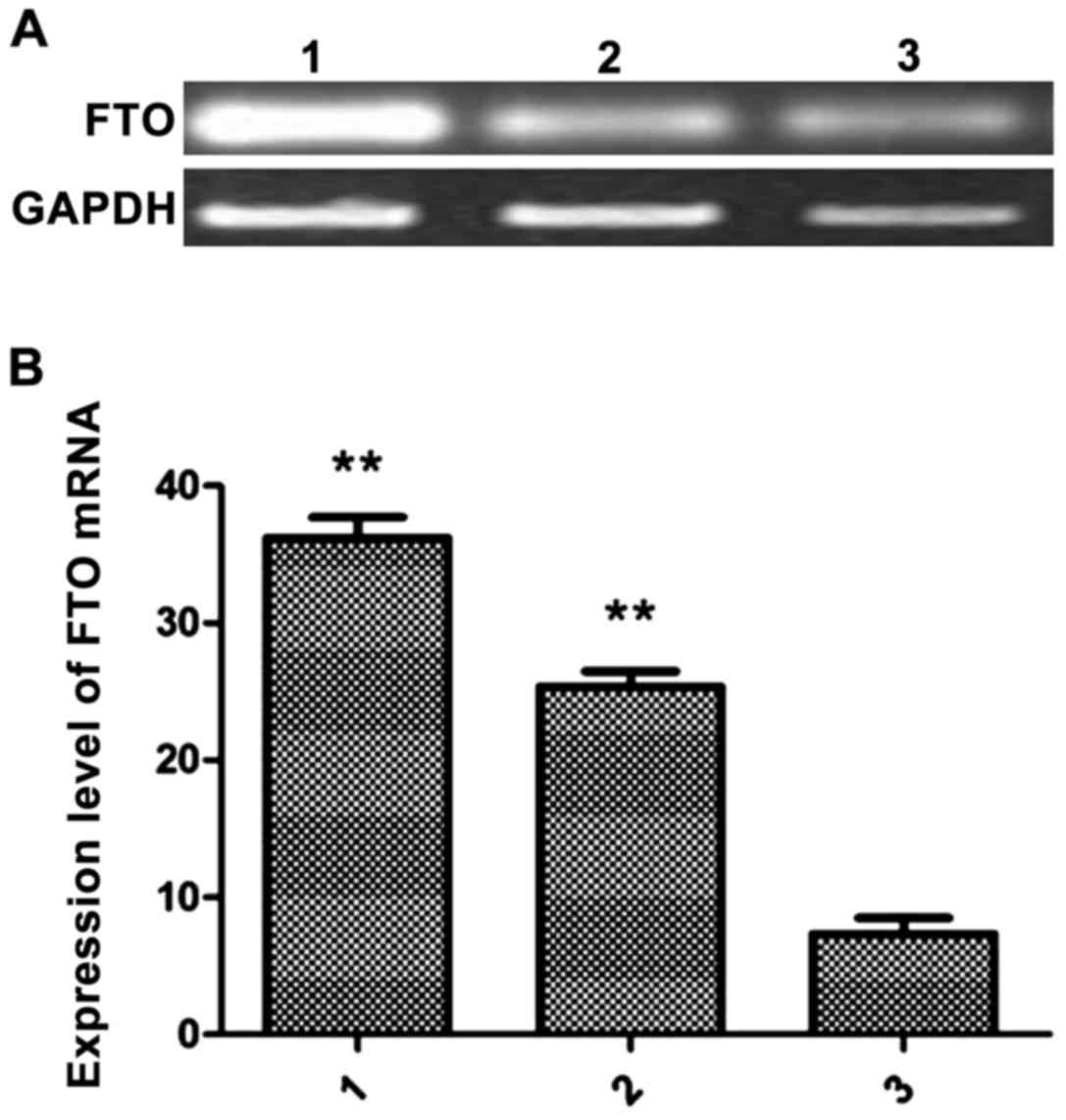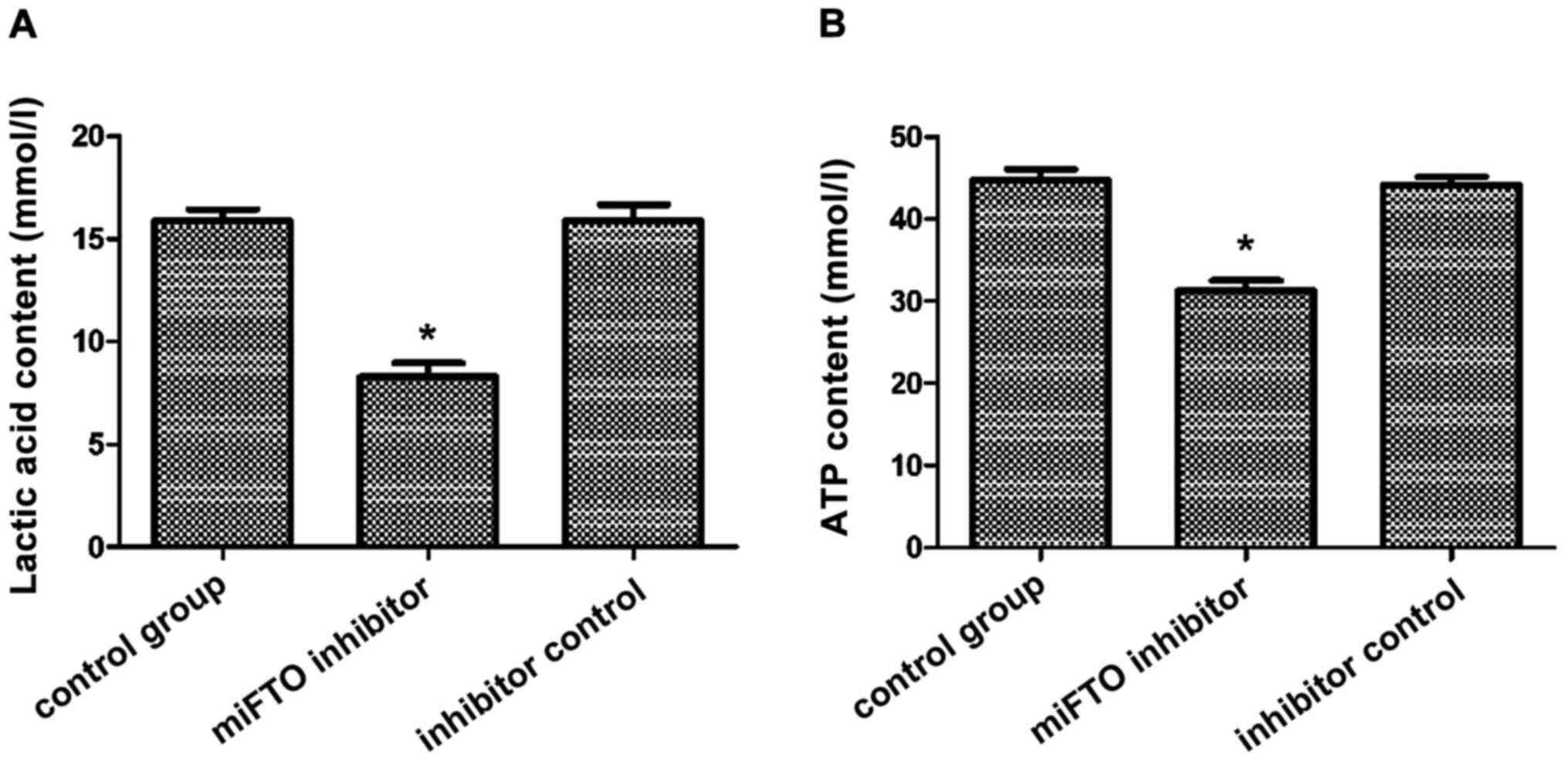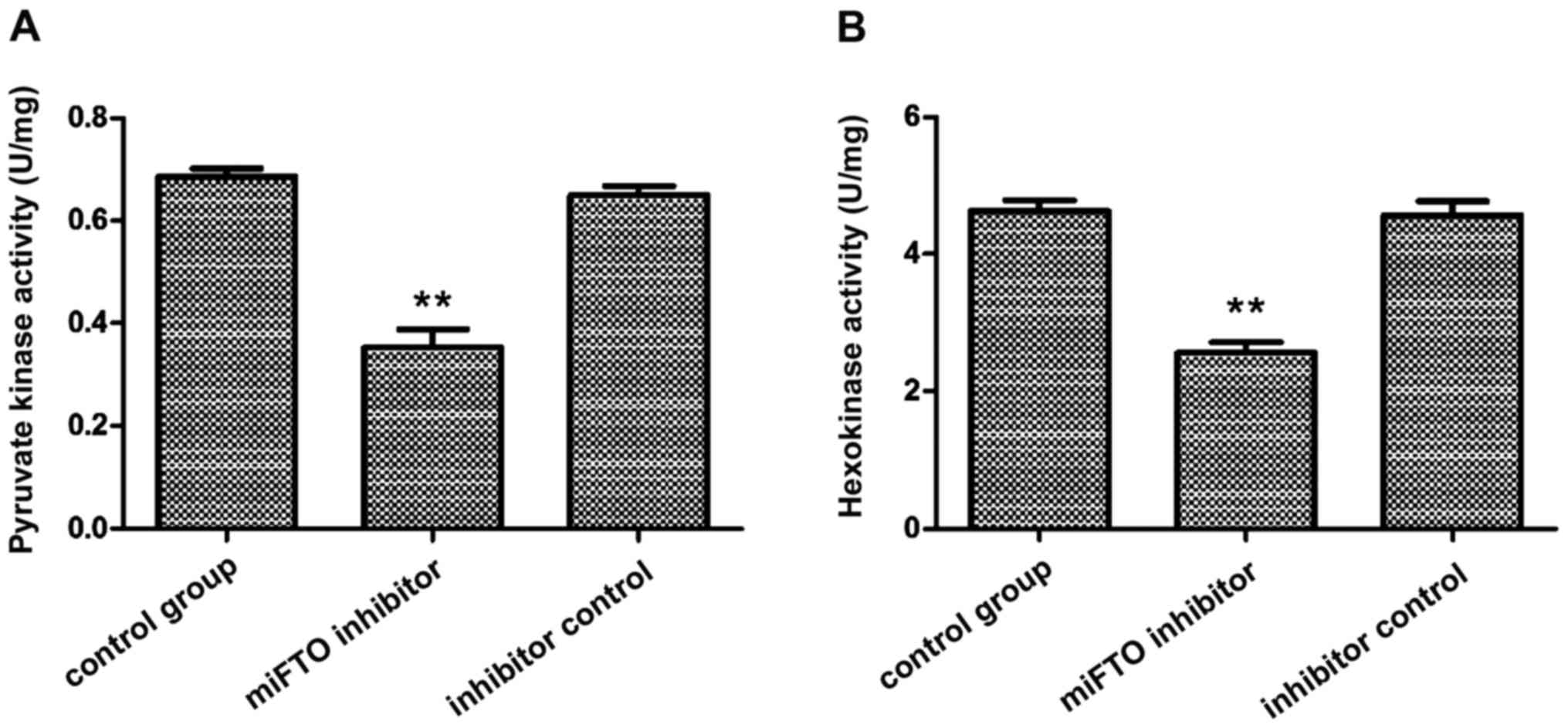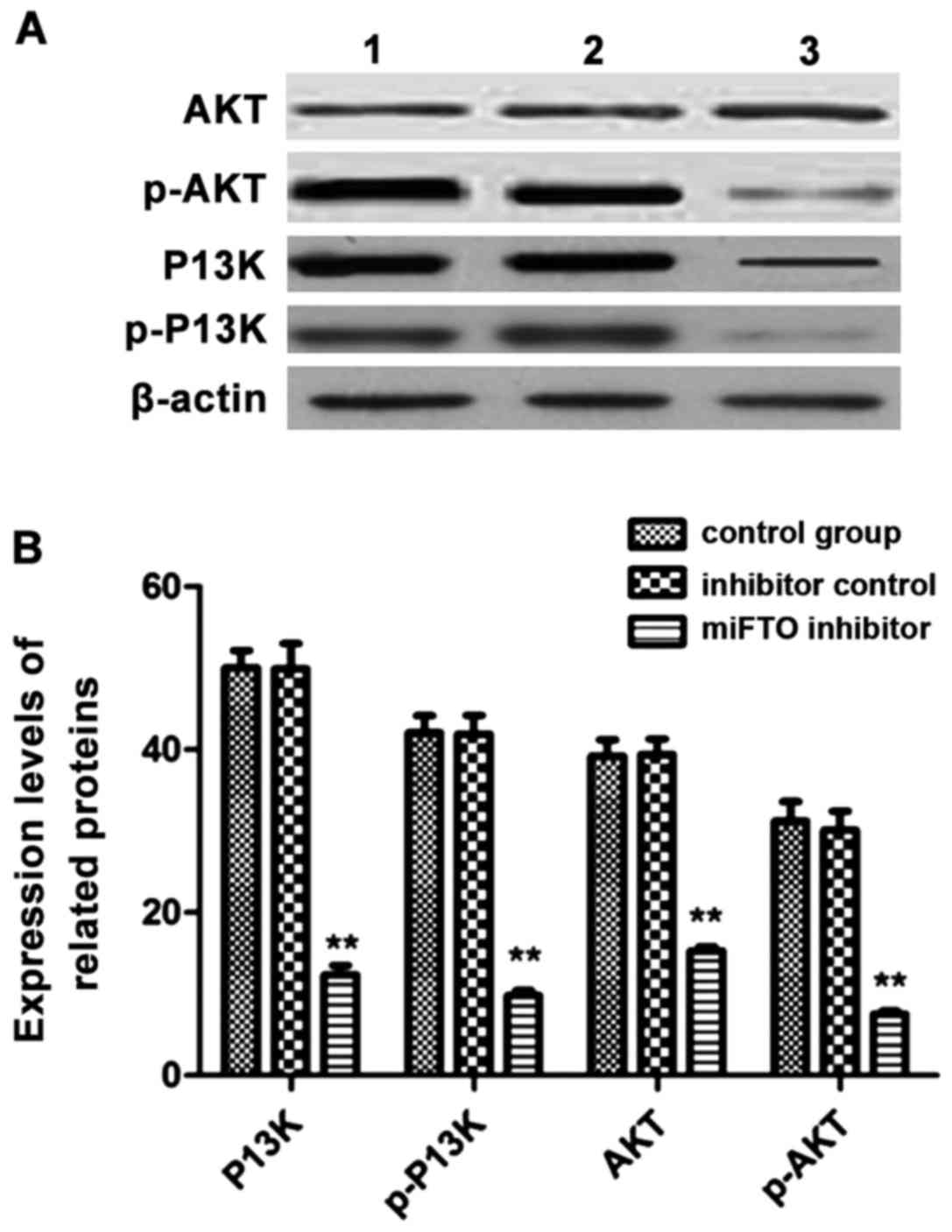The lipid metabolism gene FTO influences breast cancer cell energy metabolism via the PI3K/Akt signaling pathway
- Authors:
- Published online on: April 13, 2017 https://doi.org/10.3892/ol.2017.6038
- Pages: 4685-4690
-
Copyright: © Liu et al. This is an open access article distributed under the terms of Creative Commons Attribution License.
Abstract
Introduction
Breast cancer is a common malignant tumor in women. According to statistics, breast cancer accounts for 10% of malignant tumors and its incidence is second to that of uterine endometrial carcinoma (1). There are several causes of breast cancer. Early detection is difficult, women aged 40–60 years are at high risk for breast cancer, and its incidence is highest during the peri-menopausal period (2). Since breast cancer relapses and metastasizes easily, and has poor prognosis, there are great challenges in diagnosis and treatment of breast cancer.
In recent years, obesity was shown to increase the risk of a variety of diseases (3). Additional studies revealed that obesity related genes, such as fat mass and obesity-associated (FTO) are widely expressed in the human body (4). The FTO gene was found to be overexpressed in prostate cancer, pancreatic cancer, endometrial cancer and liver cancer. Its overexpression affected the energy metabolism of cancer cells, and was closely related to the occurrence and development of cancer (5). To our knowledge, there are no studies on the effect of FTO gene expression on breast cancer cell energy metabolism. In the present study, we used breast cancer cells as a model to explore the relationship between FTO gene expression and energy metabolism, and performed preliminary studies on its mechanism of action, to provide a new potential target for the treatment and diagnosis of breast cancer.
Materials and methods
Cells
The human breast cancer cell lines (MCF-7 and MDA-MB-231), and human breast cells (HCC1937) purchased from Cell Bank of Chinese Academy of Sciences (Shanghai, China) were used. Additional instruments and reagents used are shown in Table I. MCF-7, MDA-MB-231 and HCC1937 cells were removed from storage in liquid nitrogen and thawed in a water bath set to 37°C. Cells were then added to culture medium [Dulbecco's modified Eagle's medium/F12 (DMEM/F12) supplemented with 5% fetal bovine serum (FBS), 0.1 mg/ml streptomycin, 100 U/ml penicillin and 2 mmol/l glutamine]. Cells were grown in culture bottles in an incubator (37°C, 5% CO2) for 48 h. Culture medium was removed when cells reached 90% confluence. Cells were trypsinized in 0.25% trypsin, and centrifuged at 800 × g for 10 min at room temperature. Cells were washed with DMEM/F12 and then seeded again in cell culture bottles.
RT-PCR
TRIzol was added to cell lysis buffer for lysis of MCF-7, MDA-MB-231 and HCC1937 cells that were in the logarithmic growth phase. After 5 min of digestion, lysates were placed in new Eppendorf (EP) tubes (Corning, Inc., Corning, NY, USA), and 200 µl chloroform was added. Solutions were shaken up and down 15 times, and placed at room temperature for 5 min. Samples were then centrifuged (8,500 × g, 4°C, 10 min). RNA in the supernatant was transferred to new EP tubes. Next, 75% ethanol was added and samples were centrifuged (6,500 × g, 4°C, 5 min). The supernatant was discarded, and solutions were placed on a super-clean worktable to air dry. DEPC water (Biosharp, Hefei, China) was then added and mixed well. The concentration and purity of RNA were determined by UV spectrophotometry. According to the instructions of the reverse transcription kit, RNA was reverse transcribed into cDNA. Real-time PCR amplification of cDNA was performed to measure the expression of FTO mRNA in each group of cells.
Transfection
After trypsinization of MDA-MB-231 cells in the logarithmic growth phase, cells were washed with DMEM/F12, cell growth medium was added, and the cell concentration was adjusted to 2×105/ml. Cells were then seeded in 6-well culture plates, and placed at 37°C, 5% CO2 for 48 h. When cells were 50% confluent, growth medium was replaced with incomplete culture medium (without FBS), and placed at 37°C, 5% CO2 for 1 h. The incomplete, serum-free medium was mixed with miFTO inhibitor or inhibitor control, and incubated at 37°C for 5 min (solution A). The serum-free medium was mixed with Lipofectamine 2000 (solution B) (KeyGen, Nanjing, China). Next, solutions A and B were mixed, and left to incubate at room temperature for 20 min. The cell culture medium was discarded, and cells were repeatedly washed with phosphate-buffered saline (PBS). The transfection reagent and miRNA were added to the cell culture plates, and cells were placed at 37°C, 5% CO2 for 6 h. The medium was replaced with complete culture medium, and cells were left in the incubator for an additional 48 h.
Measurement of lactic acid content in culture medium of breast cancer cells after transfection
MDA-MB-231 cells were transfected with miFTO inhibitor, or inhibitor control and left to incubate at 37°C, 5% CO2 for 48 h. Culture supernatant was harvested and transferred to EP tubes, and centrifuged (800 × g, 5 min). The content of lactic acid in supernatant was measured according to the instructions of the Sigma Lactic Acid Test kit (Sigma-Aldrich, St. Louis, MO, USA).
Detection of ATP content in transfected cells
Transfected MDA-MB-231 cells grown in the incubator (37°C, 5% CO2) for 48 h were trypsinized and washed with PBS. Cell culture medium was added to resuspend the cells, then cells were transferred to EP tubes and centrifuged (800 × g, 5 min). The supernatant was discarded. Cells were washed twice with PBS and the supernatant was discarded after centrifugation at 800 × g for 3 min. The cells were mixed homogeneously with ultrapure water. The cell homogenates were transferred to EP tubes and heated in a water bath (100°C, 10 min). The content of ATP was determined according to the instructions of the ATP test kit.
Detection of hexokinase and pyruvate kinase activity in breast cancer cells
MDA-MB-231 cells were transfected with miFTO inhibitor or inhibitor control for 48 h. The activity of hexokinase and pyruvate kinase were detected according to the instructions of the hexokinase and pyruvate kinase test kits.
Western blot analysis
After 48 h culture, culture medium from transfected MDA-MB-231 cells was discarded, cells were washed with PBS and lysed on ice for 30 min. Protein extracts were mixed with loading buffer, and boiled at 100°C for 5 min. A total volume of 50 µl of the denatured protein samples were loaded on gels (12% separation gel and 5% spacer gel). A voltage of 80 V was applied to samples and then adjusted to 120 V when protein reached the separation gel. When bromophenol blue entered the separation gel, electrophoresis was stopped. Protein was transferred to PVDF membranes overnight at 4°C. PVDF membranes were washed with TBST 3 times, and blocked with skim milk for 2 h at 37°C. Membranes were treated with primary antibody overnight at 4°C, washed with TBST, and incubated with secondary antibody for 1.5 h at room temperature. Membranes were washed and developed. Protein expression was analyzed with the Odyssey scanning system (LI-COR, Inc., Lincoln, NE, USA). Primary rabbit polyclonal AKT antibody (dilution, 1:500; cat. no. ab38449); rabbit monoclonal p-AKT antibody (dilution, 1:500; cat. no. ab81283), rabbit monoclonal PI3K antibody (dilution, 1:500; cat. no. ab86714), rabbit polyclonalp-PI3K antibody (dilution, 1:500; cat. no. ab182651) and secondary goat anti-rabbit (HRP) IgG antibody (dilution, 1:2,000; cat. no. ab6721) were all purchased from Abcam (Cambridge, MA, USA).
Statistical analysis
Data were analyzed with SPSS 16.0 statistical software (SPSS, Inc., Chicago, IL, USA). Comparisons between groups were by t-test. P<0.05 was considered to indicate a statistically significant difference.
Results
Measurement of FTO mRNA expression in breast cancer cells and breast cells by RT-PCR
In the logarithmic growth phase, MCF-7, MDA-MB-231 and HCC1937 cells were harvested for extraction of total RNA. The expression levels of FTO in the 3 groups of cells were detected by real-time quantitative PCR. The relative expression levels of FTO mRNA in MCF-7 cells was 26.89±2.31, 36.23±2.91 in MDA-MB-231 cells and 8.96±3.01 in HCC1937 cells. The levels of FTO mRNA in MCF-7 and MDA-MB-231 cells were significantly higher than in HCC1937 cells (P<0.01) (Fig. 1).
Measurement of lactic acid and ATP content
The content of lactic acid and ATP in MDA-MB-231 cells transfected with the miFTO inhibitor or inhibitor control were detected according to the lactic acid test kit and ATP test kit. After 48 h culture, the lactic acid content of the miFTO inhibitor group was 8.97±0.25 mmol/l, the lactic acid content of the inhibitor control group was 17.11±1.02 mmol/l, and the lactic acid content of the blank control group was 17.08±1.32 mmol/l. The lactic acid content of breast cancer cells transfected with miFTO inhibitor was significantly lower compared with the control group and inhibitor control group. FTO mRNA inhibitors can inhibit the production of lactic acid in breast cancer cells (Fig. 2A). After 48 h culture, the ATP content of the miFTO inhibitor group was 31.45±1.58 mmol/l, the ATP content of the inhibitor control group was 44.12±3.12 mmol/l, and the ATP content of the blank control group was 44.56±2.45 mmol/l. The ATP content of breast cancer cells transfected with the miFTO inhibitor was significantly lower compared with the control group and inhibitor control group (P<0.05). FTO mRNA inhibitors can inhibit the production of ATP in breast cancer cells (Fig. 2B).
Detection of pyruvate kinase and hexokinase activity
The activity of hexokinase and pyruvate kinase in MDA-MB-231 cells transfected with miFTO inhibitor or inhibitor control were detected according to the instructions of the hexokinase and pyruvate kinase test kits. The results showed that pyruvate kinase activity in breast cancer cells transfected with miFTO inhibitor and inhibitor control were 0.39±0.01 and 0.68±0.02, respectively, and 0.71±0.03 in the nontransfected cells. Pyruvate kinase activity of breast cancer cells transfected with miFTO inhibitor was significantly lower compared with the control group and inhibitor control group (P<0.01). Hexokinase activity in breast cancer cells transfected with the miFTO inhibitor and inhibitor control were 2.54±0.21 and 4.86±0.25, respectively, and 4.84±0.20 in the nontransfected cells. Hexokinase activity of breast cancer cells transfected with the miFTO inhibitor was significantly lower compared with the control group and inhibitor control group (P<0.01). Therefore, miFTO inhibitors can reduce the activity of hexokinase and pyruvate kinase in breast cancer cells (Fig. 3).
Western blot analysis to detect the expression levels of related proteins in cells
MDA-MB-231 cells transfected with the miFTO inhibitor or inhibitor control for 48 h were harvested, and lysates were used to analyze the expressions of phosphatidylinositol 3-kinase (PI3K), p-PI3K, protein kinase B (Akt), and p-AKT by western blot analysis. After transfection with the miFTO inhibitor, the expressions of PI3K, p-PI3K, AKT and p-AKT were significantly lower compared with the control group and inhibitor control group. The phosphorylated forms of PI3K and AKT decreased significantly (Fig. 4).
Discussion
Breast cancer is a common malignant tumor in women. According to statistics, the incidence of breast cancer accounts for 10% of all malignant tumors. There are 1.3 million newly diagnosed cases of breast cancer worldwide every year, and ~50 million people die from breast cancer each year. Therefore, breast cancer is a serious threat to the health of women. The occurrence of breast cancer has regional differences. The morbidity of breast cancer in developed countries is higher than that in developing countries (6). There are several causes of breast cancer and it is difficult to detect in the early stage. Research on the pathogenesis of breast cancer is important for treatment and diagnosis.
In recent years, studies have shown that obesity can increase the risk of breast cancer. Obese women were 3 times more likely to have breast cancer than nonobese women (3). The lipid metabolism gene FTO, has been found to be closely related to obesity. The FTO gene contains nine exons and is located on chromosome 16. It is widely expressed in adults and in the fetus. FTO is most highly expressed in the pituitary, pancreatic islets, hypothalamus and adrenal glands (7,8). FTO is overexpressed in prostate cancer, pancreatic cancer, hepatocellular carcinoma and endometrial carcinoma. It therefore has a close relationship with the occurrence and development of cancer. In this study, we used human breast cancer cells (MCF-7 and MDA-MB-231) and human breast cells (HCC1937) to determine the levels of FTO mRNA by real-time fluorescence quantitative PCR. The results showed that the FTO mRNA levels in breast cancer cells were significantly higher than in normal breast cells, suggesting that FTO is an oncogene, which represents a potential new marker for the early diagnosis of breast cancer.
Cell energy metabolism is the process of transforming organic matter into energy. In normal cells, ATP is produced by oxidative decomposition of glucose, which can be divided into aerobic oxidation and glycolysis (9,10). Glucose can be oxidized to produce ATP under aerobic conditions, while under anoxic conditions, ATP can be generated by glycolysis (11). The energy metabolism of tumor cells is different from that of normal cells. In cases where tumor cells receive sufficient oxygen, energy is also produced by glycolysis which converts pyruvate to lactic acid (the ‘Warburg effect’) (12). Studies have shown that aerobic glycolysis can be found in lung cancer, breast cancer, colon cancer and renal cancer cells (13). Pyruvate kinase and hexokinase play a key role in glycolysis. In tumor cells, hexokinase exists as isozymes. The expression of hexokinase is related to the occurrence and development of colon cancer and renal cell carcinoma. Downregulated expression of pyruvate kinase can inhibit the production of lactic acid by glycolysis (14). In this study, after cells were transfected with the FTO mRNA inhibitor, the ATP levels in breast cancer cells decreased, pyruvate kinase and hexokinase activity decreased significantly, and the content of lactic acid in the medium decreased significantly. These results demonstrate that overexpression of the FTO gene could promote glycolysis in breast cancer cells.
The role of the PI3K/AKT signaling pathway in tumor cells is an area of intense study (15,16). The PI3K/AKT signaling pathway is related to the proliferation and apoptosis of cancer cells, and can regulate the activity of caspase-9 (17), p53 (18), Bad (19), and other proteins, and inhibit apoptosis. The PI3K/AKT signaling pathway is active in several types of cells, and it plays an important role when cells are under hypoxic conditions. Under hypoxic conditions, the PI3K/AKT signaling pathway can upregulate insulin, epidermal growth factor and cytokine expression. It can deliver messages to protein tyrosine kinases via transmembrane receptors, activate PI3K, and catalyze the generation of PIP3, which then delivers messages to Akt, and activates the Ras-MAPK signaling pathway, which consequently causes a series of complex reactions in the body (20,21). In this study, through transcriptional inhibition of the FTO gene, the protein expression of PI3K, p-PI3K, Akt and p-Akt in cells increased significantly according to western blot analysis, demonstrating that expression of the FTO gene affected the energy metabolism of breast cancer cells through the PI3K/AKT signaling pathway.
In conclusion, overexpression of FTO in breast cancer cells can result in upregulation of pyruvate kinase and hexokinase activity, increase the amount of ATP generation in cells, and promote glycolysis and lactic acid production. FTO overexpression affects the energy metabolism of breast cancer cells, and the mechanism is related to the PI3K/AKT signaling pathway. Our results represent a potential new therapeutic option for the treatment and diagnosis of breast cancer.
References
|
Piccart-Gebhart MJ, Procter M, Leyland-Jones B, Goldhirsch A, Untch M, Smith I, Gianni L, Baselga J, Bell R, Jackisch C, et al: Herceptin Adjuvant (HERA) Trial Study Team: Trastuzumab after adjuvant chemotherapy in HER2-positive breast cancer. N Engl J Med. 353:1659–1672. 2005. View Article : Google Scholar : PubMed/NCBI | |
|
Dowsett M, Forbes JF, Bradley R, Ingle J, Aihara T, Bliss J, Boccardo F, Coates A, Coombes RC, Cuzick J, et al: Early Breast Cancer Trialists' Collaborative Group (EBCTCG): Aromatase inhibitors versus tamoxifen in early breast cancer: patient-level meta-analysis of the randomised trials. Lancet. 386:1341–1352. 2015. View Article : Google Scholar : PubMed/NCBI | |
|
Gallagher EJ and LeRoith D: Obesity and diabetes: the increased risk of cancer and cancer-related mortality. Physiol Rev. 95:727–748. 2015. View Article : Google Scholar : PubMed/NCBI | |
|
Sevgi M, Rigoux L, Kühn AB, Mauer J, Schilbach L, Hess ME, Gruendler TO, Ullsperger M, Stephan KE, Brüning JC, et al: An obesity-predisposing variant of the FTO gene regulates D2R-dependent reward learning. J Neurosci. 35:12584–12592. 2015. View Article : Google Scholar : PubMed/NCBI | |
|
Milagro FI, Moreno-Aliaga MJ and Martinez JA: FTO obesity variant and adipocyte browning in humans. N Engl J Med. 374:190–191. 2016. View Article : Google Scholar : PubMed/NCBI | |
|
Kuchenbaecker KB, Ramus SJ, Tyrer J, Lee A, Shen HC, Beesley J, Lawrenson K, McGuffog L, Healey S, Lee JM, et al: EMBRACE; GEMO Study Collaborators; Breast Cancer Family Registry; HEBON; KConFab Investigators; Australian Cancer Study (Ovarian Cancer Investigators); Australian Ovarian Cancer Study Group; Consortium of Investigators of Modifiers of BRCA1 and BRCA2: Identification of six new susceptibility loci for invasive epithelial ovarian cancer. Nat Genet. 47:164–171. 2015. View Article : Google Scholar : PubMed/NCBI | |
|
Hasstedt SJ, Coon H, Xin Y, Adams TD and Hunt SC: APOH interacts with FTO to predispose to healthy thinness. Hum Genet. 135:201–207. 2016. View Article : Google Scholar : PubMed/NCBI | |
|
Salgado-Montilla J, Rodríguez-Caban J, Gonzalez-Sepulveda L, Sanchez-Ortiz R and Irizarry-Ramirez M: Presence of FTO rs9939609 and rs9930506 and severity of prostate cancer in Puerto Ricans. Cancer Res (106th Annual Meeting Abstracts). pp. 48362015; | |
|
Barbier-Torres L, Delgado TC, García-Rodríguez JL, Zubiete-Franco I, Fernández-Ramos D, Buqué X, Cano A, Gutiérrez-de Juan V, Fernández-Domínguez I, Lopitz-Otsoa F, et al: Stabilization of LKB1 and Akt by neddylation regulates energy metabolism in liver cancer. Oncotarget. 6:2509–2523. 2015. View Article : Google Scholar : PubMed/NCBI | |
|
Roberts DJ and Miyamoto S: Hexokinase II integrates energy metabolism and cellular protection: akting on mitochondria and TORCing to autophagy. Cell Death Differ. 22:248–257. 2015. View Article : Google Scholar : PubMed/NCBI | |
|
Giménez-Cassina A and Danial NN: Regulation of mitochondrial nutrient and energy metabolism by BCL-2 family proteins. Trends Endocrinol Metab. 26:165–175. 2015. View Article : Google Scholar : PubMed/NCBI | |
|
Valenti D, Vacca RA and de Bari L: 3-Bromopyruvate induces rapid human prostate cancer cell death by affecting cell energy metabolism, GSH pool and the glyoxalase system. J Bioenerg Biomembr. 47:493–506. 2015. View Article : Google Scholar : PubMed/NCBI | |
|
Gatenby RA and Gillies RJ: Why do cancers have highaerobic glycolysis? Nat Rev Cancer. 4:891–899. 2004. View Article : Google Scholar : PubMed/NCBI | |
|
Vincent EE, Sergushichev A, Griss T, Gingras MC, Samborska B, Ntimbane T, Coelho PP, Blagih J, Raissi TC, Choinière L, et al: Mitochondrial phosphoenolpyruvate carboxykinase regulates metabolic adaptation and enables glucose-independent tumor growth. Mol Cell. 60:195–207. 2015. View Article : Google Scholar : PubMed/NCBI | |
|
Liang M, Liu J, Ji H, Chen M, Zhao Y, Li S, Zhang X and Li J: A Aconitum coreanum polysaccharide fraction induces apoptosis of hepatocellular carcinoma (HCC) cells via pituitary tumor transforming gene 1 (PTTG1)-mediated suppression of the P13K/Akt and activation of p38 MAPK signaling pathway and displays antitumor activity in vivo. Tumour Biol. 36:7085–7091. 2015. View Article : Google Scholar : PubMed/NCBI | |
|
Zhang CZ, Wang XD, Wang HW, Cai Y and Chao LQ: Sorafenib inhibits liver cancer growth by decreasing mTOR, AKT, and PI3K expression. J BUON. 20:218–222. 2015.PubMed/NCBI | |
|
Zhu JJ, Cui Y, Cui K, Li X and Zhang ZY: Distinct roles of parafibromin in the extracellular environment, cytoplasm and nucleus of osteosarcoma cells. Am J Transl Res. 8:2426–2431. 2016.PubMed/NCBI | |
|
Mock CD, Jordan BC and Selvam C: Recent advances of curcumin and its analogues in breast cancer prevention and treatment. RSC Advances. 5:75575–75588. 2015. View Article : Google Scholar : PubMed/NCBI | |
|
Yang Z, Xie C, Xu W, Liu G, Cao X, Li W, Chen J, Zhu Y, Luo S, Luo Z, et al: Phosphorylation and inactivation of PTEN at residues Ser380/Thr382/383 induced by Helicobacter pylori promotes gastric epithelial cell survival through PI3K/Akt pathway. Oncotarget. 6:31916–31926. 2015.PubMed/NCBI | |
|
Pande M, Bondy ML, Do KA, Sahin AA, Ying J, Mills GB, Thompson PA and Brewster AM: Association between germline single nucleotide polymorphisms in the PI3K-AKT-mTOR pathway, obesity, and breast cancer disease-free survival. Breast Cancer Res Treat. 147:381–387. 2014. View Article : Google Scholar : PubMed/NCBI | |
|
Bains M and Roberts JL: Estrogen protects against dopamine neuron toxicity in primary mesencephalic cultures through an indirect P13K/Akt mediated astrocyte pathway. Neurosci Lett. 610:79–85. 2016. View Article : Google Scholar : PubMed/NCBI |














